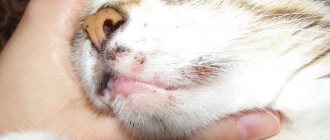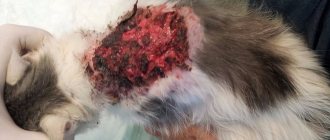It happens that a beloved pet receives a gift from nature of neighbors in the body - worms. Not the most pleasant neighborhood, from which the animal’s body will suffer for a long time if the owner does not undertake deworming. Worms in a cat - a serious disease that depresses all body systems: the animal loses weight, eats poorly, and becomes very tired.
Where does such a misfortune come from? Such unkind guests easily enter the body, but leave with reluctance. If you suspect unwanted neighbors, it is better to visit the veterinarian and find out who decided to destroy the cat from the inside.
Types of worms in cats and cats
Worms in cats come in different sizes and shapes, and they feed and reproduce differently. They have long been classified into three categories: flukes, tapeworms, and roundworms. Let's study the enemy!
| Name | Peculiarities | Symptoms in a cat |
| Lungworms | This infection enters the cat if it drinks from a dirty source or eats crustaceans. Tapeworms destroy the lungs with cyst-like formations |
|
| Cucumber tapeworm | The parasite can easily take up residence in both the cat’s body and the human body. In a cat, the size of a tapeworm rarely exceeds a length of 30 cm. The danger is expressed by damage to the intestinal walls. The parasite can be brought by fleas and lice eaters. | The pet is vomiting, losing weight, and is irritable. My stomach is constantly rumbling and I have diarrhea. |
| Wide tapeworm | The parasite grows in the body up to 1.5 meters in an animal, and up to 12 meters in a person. You can become infected by eating raw fish, crustaceans and drinking river water. |
|
| Liver fluke | The fluke has chosen the liver as its home and does not disdain the pancreas and gall bladder. To acquire such a neighbor, you can eat raw fish. | The vomit is colored in shades of yellow, there is no appetite, the animal is weakened. Diarrhea appears and the temperature may rise. Complex treatment is used here, due to the ineffectiveness of standard treatment. |
| Causative agents of alveococcosis | The parasite reaches a length of 4-5 mm and does not pose a danger to the cat. For many years this neighborhood has been quite peaceful, but as soon as a person becomes infected, trouble will strike. It is difficult to make a diagnosis; the patient faces death due to metastases to various organs, and a liver tumor develops. The worm can enter the body as a result of eating a rodent. | There are no symptoms. |
| Toxocars | The localization of five-centimeter helminths is the esophagus, gall bladder and liver. The source of infection is food, and cases of intrauterine infection are also known. The parasite is dangerous for kittens, as the rapid development of toxocara begins, which is fraught with ruptures in the small intestine. | No symptoms observed |
| Hookworms | The size of these guests of the cat’s body does not exceed 1 cm. Hookworms choose the intestines as their place of residence, and blood as their source of nutrition. Helminth eggs can enter the body with food, and the larvae can even penetrate the skin of a pet. | Appetite is reduced, the animal is lethargic and apathetic to everything. The stool is liquid and there is visible blood in it. The cat is vomiting and coughing a lot. |
These are the main parasitic creatures that can seriously complicate the life of a pet and its owner.
Is it possible to get worms from a cat?
global $ads_google;
//data-ad-slot=”2475549904″ $ads_google = empty($ads_google) ? false : true; ?> if ($ads_google == false) {?> $ads_google = true; ?> } ?> There are approximately 32 known varieties of worms in cats , which will not deny themselves the pleasure of settling in the human body. The consequences of such proximity in animals and humans can manifest themselves differently. If a pet’s body can calmly coexist with some types of helminths, then in some cases the consequences for humans are serious.
Infection occurs after the eggs or larvae of worms enter the oral cavity. Basically, they get there through the hands. Even if several hours have passed after contact with the pet, parasite eggs remain on the hands. A cat, licking its fur, spreads pathogens through it from its anus, where the larvae and eggs of helminths accumulate. A person pets a furry friend, forgets to wash his hands with soap, and soon finds out that he has new little “friends” in himself.
Worms are transmitted not only from direct contact with the cat, but also through his things and litter box.
Worms dangerous to humans
Let's look at helminths that are transmitted from cats to humans and are dangerous:
- Flatworms cause a disease called opisthorchiasis. The parasite settles in the liver, gall bladder and pancreas, affecting the ducts of these organs. You can get sick by eating raw or poorly cooked fish, mainly from the carp family;
- The wide tapeworm of the cestodoses group causes diphyllobothriasis. The worm occupies the small intestine and grows up to 10 meters. Iron deficiency anemia and dyspeptic disorders gradually develop. Raw freshwater fish can also become a source of infection;
- Echinococcus in the larval stage can seriously affect the internal organs of a person. Cats also carry the dangerous disease alveococcosis to humans. Contact with a sick animal can be fatal for people.
Hygiene remains the main barrier to the transmission of such diseases.
Prevention of worms
It is much easier to prevent the occurrence of worms and the progression of the disease. To do this, deworming procedures should be carried out in cats and kittens at least four times a year. It is also important to observe cleanliness and hygiene standards to ensure that everything is in order with your pet’s health.
For preventive purposes, it is important to thoroughly wash your hands after contact with street animals to prevent infection. It is important to constantly change the tray, wash it and disinfect it to maintain normal hygiene. It is not recommended to give your pet raw food, because meat and fish can cause infection. If there are several animals in the house, then you will have to worm them all at once.
How to safely worm a cat
If it was not possible to avoid the problem, then it is important to adhere to certain rules for deworming kittens. The product should be purchased specifically for a small animal. It is important to observe the dosage, as well as the regularity of the procedure, so as not to harm the pet. If symptoms of pathology occur, then it is important to immediately visit a veterinarian to prescribe a treatment regimen.
Signs of worms in a cat
Worm infestations do not manifest themselves immediately: the development of symptoms is directly proportional to the amount of infection in the body.
Symptoms of worms in cats include a number of signs:
- depressed and apathetic state;
- problems with appetite;
- weight loss;
- fatigue;
- slow development in kittens;
- unusual condition of the coat, its disheveled appearance;
- noticeable yellowness of the mucous membranes;
- on palpation there is noticeable enlargement of the liver (trematodes);
- anemia of the mucous membranes (cestodia);
- constipation gives way to diarrhea, vomiting;
- cough;
- frequent licking of the anus due to itching;
- intoxication in the form of convulsions, paresis of the limbs;
- premature birth and sometimes miscarriage;
- blood in stool.
The list is quite large, symptoms do not appear individually, they are a whole set of signs.
Why do you need to worm your cat for the rest of your life?
Parasites appear in cats because... The cat constantly tastes everything: the floor, the entrance mat, the owner’s shoes. In these places there are worm larvae, which the cat swallows. Worms, living in the pet’s organs, injure the mucous membrane, feed on the cat’s blood and nutrients, and secrete toxins that poison the animal’s body. With severe toxicity, death occurs. Worms also cause blockage of the kitten’s intestines and rupture of the walls. If there are worms, the cat languishes, the fur becomes dull, and the animal is inactive. To avoid the consequences of parasite proliferation, it is necessary to carry out treatment at home - give an anthelmintic drug once every 3 months - even if there are no visible signs of infection in the cat.
Treatment of worms in cats
Anthelmintic treatment is prescribed by a veterinarian after testing. It is required to accurately identify the enemy and locate the source of the lesion.
Why is it necessary to consult a veterinarian? Because each anthelmintic medication acts on one type of parasite, and it is not so easy to remove worms from a cat But there are also complex drugs that act on a certain number of helminths.
The treatment regimen is simple: the drug for worms is given once in the morning, then the dose is repeated after 10 days. Deworming is also carried out 10 days before vaccination. Cats are dewormed 2-3 weeks before and 3 weeks after birth.
Remedies for worms in cats
global $ads_google;
//data-ad-slot=”2475549904″ $ads_google = empty($ads_google) ? false : true; ?> if ($ads_google == false) {?> $ads_google = true; ?> } ?> If you suspect that your cat has worms, then you need to study the list of means that can be used to deworm the animal. These are effective medications in many cases.
If the question arises about what to give your cat for worms , then veterinary pharmacies can offer tablets, suspensions and injections. There are two types of tablets: narrow-profile and complex. Narrow-profile drugs act against a specific parasite; therefore, complex drugs are effective against several helminths.
Deworming tablets for cats
Effective medications for worms include:
- sugar cubes (Polivercan) at a price of up to 50 rubles per piece;
- Kanikvantel tablet, which can be bought for 55-65 rubles;
- Drontal with a price of up to 70 rubles;
- Milbemax, which is sold in the form of two tablets from 350 rubles;
- Dirafen (35-100 rubles per package);
- Alben (35-75 rubles per package).
Sugar cubes are convenient to use - they dissolve easily in water, and the cat willingly drinks the medicine through a syringe. To properly give a pill to a cat, you need to know how to do it. Otherwise, the drug will enter the body in the wrong dosage or not at all.
Anti-worm suspension for cats
Suspensions are also used to remove worms from cats. They are given to the animal orally using a dispensing syringe.
The list of excellent effective suspensions includes the following drugs:
- Dirofen (150-180 rubles);
- Prazicide for adult cats or kittens (140-150 rubles);
- Pyrantel (in suspension, from 50 to 60 rubles);
- Prazitel (120-145 rubles).
It is easier to give the suspension to the animal, its taste is pleasant, and the cat will not protest as much as when administering a bitter tablet. Suspensions are prescribed to kittens from three months of age. Admission is carried out strictly according to the dosage indicated on the package. 6 hours after administration, the pussy is given activated charcoal to prevent the development of intoxication.
Deworming drops for cats
Drops are a convenient remedy for deworming in cats , which also act on fleas, lice and ticks.
Popular anthelmintic drops:
- Stronggold (from 200 rubles);
- Lawyer (1100 rubles);
- Profender (450 rubles);
- Dironet (from 320 to 350 rubles).
Since the drops are applied to the withers, there is no chance that the animal will lick them and become poisoned.
Deworming injections for cats
global $ads_google;
//data-ad-slot=”2475549904″ $ads_google = empty($ads_google) ? false : true; ?> if ($ads_google == false) {?> $ads_google = true; ?> } ?> Cats can be treated for helminths at home not only with tablets, drops or suspensions. Injections against worms also work quickly.
Veterinarians usually prescribe the following medications:
- Novomek (50-70 rubles);
- Ivomek (150-200 rubles);
- Barmek.
Injections are not used without consultation with a specialist.
Traditional methods for parasites
Treatment of cats for worms can also be carried out using folk remedies that have proven their effectiveness over time. Compared to factory-made drugs, they have some advantages, in particular, they can be given to cats during estrus and pregnancy, as well as to kittens.
There are also disadvantages - the duration of treatment and the ability of some drugs to cause allergies in the pet. For this reason, veterinarians do not encourage this type of treatment.
How to rid a cat of worms at home:
- A decoction of fennel and chamomile. Brew 2 tablespoons of the dried plant, strain, and give to the cat instead of water.
- Onion infusion. Cut a small onion in half and add hot water. The pet should drink the solution once a day. Treatment lasts a week.
- Tincture of wormwood or tansy. Pour boiling water over 1 tablespoon of the plant, cool and give to the cat three times a day. Do not feed the animal for an hour after taking the tincture. Alcohol tincture of wormwood can be given 10 drops per day an hour before feeding.
- Enemas of fresh carrot juice (a little less than a tablespoon). Cleanse the intestines once a day for a week.
- Chopped garlic (one clove is enough), which is mixed into food for 7 days.
- Pumpkin seeds. Peel 300 grams of seeds, being careful not to damage the green shell, add water (50 ml) and add a little honey. Let the solution brew and use it for enemas or medicinal drinks.
INTERESTING TO KNOW: If the cat is blind
Some cat owners believe that worms can be cured with the help of celandine. However, this plant contains poisonous alkaloids, so it cannot be used for these purposes!
How to give a cat a deworming tablet
Giving a cat a pill is not an easy task. No matter how hard you try to persuade the animal to open its mouth and swallow the “delicacy,” there will be no result. There is a standard algorithm of actions that will help feed a cat a medicinal drug.
It is best to crush the tablet into powder and roll it into a ball with a tasty treat, sit the animal with its back to you and unclench its jaws. The medicinal ball is stuffed into the pet’s mouth and closed, stroking the pussy’s throat. As soon as the swallowing movement is made, you need to make sure that the medication is swallowed.
There are other ways to give your cat the pill.
If a pregnant cat has worms
If a cat is pregnant, the owner will clearly be concerned about the health of the expectant mother and her offspring. For this purpose, preventive measures are carried out three weeks before mating, treating both the groom, if necessary, and the bride. However, if the pussy is preparing to become a mother and has managed to catch helminths, then you need to check with the veterinarian what treatment is appropriate to prescribe based on the test results. There are anthelmintic drugs that have no contraindications for pregnant cats, but there are instructions for taking medications regarding the period. Some medications for cat worms are indicated for the initial stage of pregnancy, and some can be taken in the last weeks.











